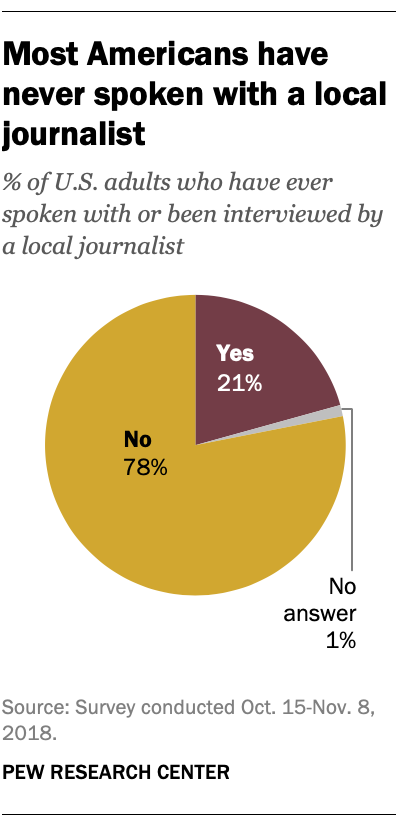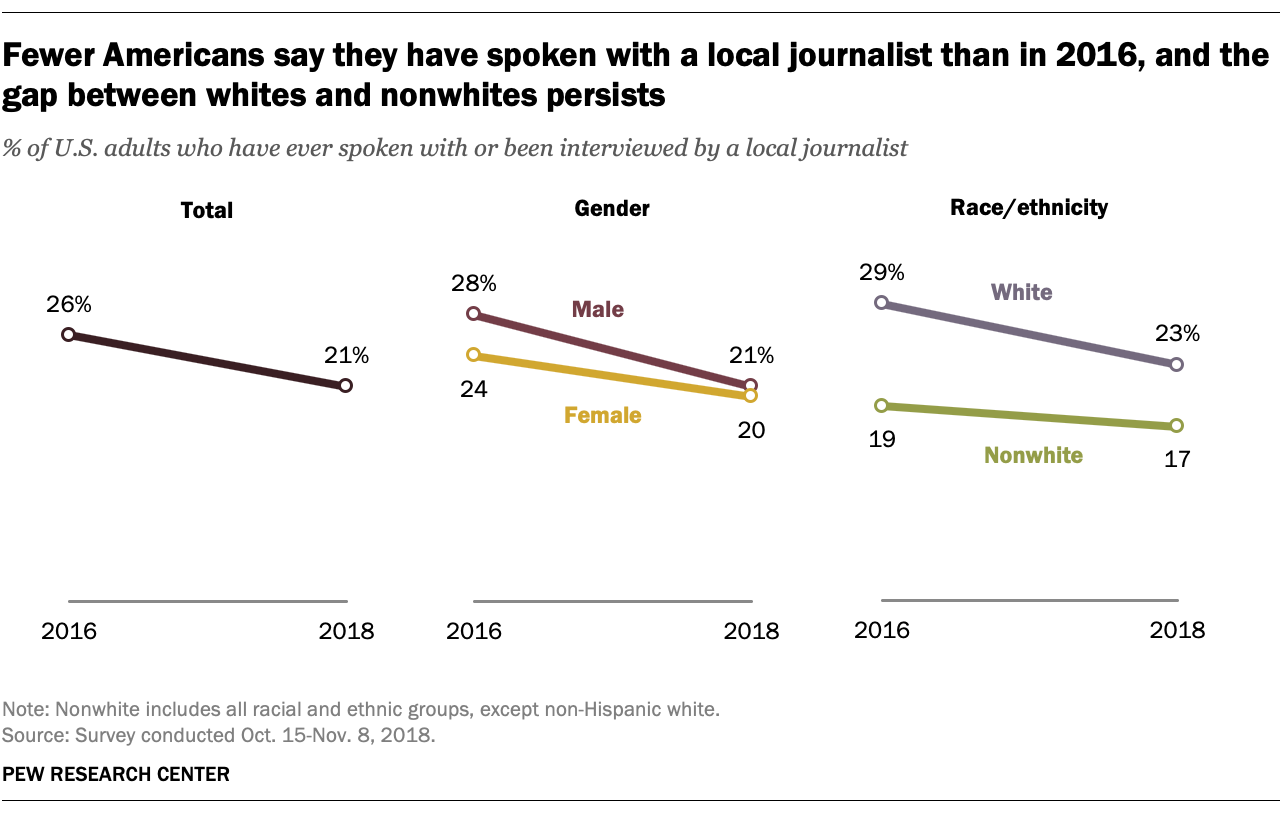
 About two-in-ten Americans (21%) say they have ever spoken with or been interviewed by a local journalist, according to a recent Pew Research Center survey. Among those who have, the likelihood varies by personal characteristics.
About two-in-ten Americans (21%) say they have ever spoken with or been interviewed by a local journalist, according to a recent Pew Research Center survey. Among those who have, the likelihood varies by personal characteristics.
About 23% of whites have had this kind of interaction, compared with 19% of blacks and 14% of Hispanics, according to the survey, conducted Oct. 15-Nov. 8, 2018, among nearly 35,000 U.S. adults.
Older Americans are also more likely to have had personal contact with a local journalist: A quarter of U.S. adults ages 65 and over have done so, compared with 17% of those ages 18 to 29. (This may not come as a surprise: Since the question asked whether Americans have “ever” spoken to a local journalist, older adults have had more time – and a greater chance – to interact with a local reporter.)
 Educational attainment and income are also tied to Americans’ likelihood of having talked with local news media. The highly educated – those with at least a college degree – are about twice as likely as those with a high school degree or less to have spoken with a local journalist (27% vs. 14%, respectively). And while 26% of those with an income of $75,000 or more have spoken with a local journalist, the share falls to 20% of those who earn between $30,000 and $74,999 and 17% of those who make less than $30,000.
Educational attainment and income are also tied to Americans’ likelihood of having talked with local news media. The highly educated – those with at least a college degree – are about twice as likely as those with a high school degree or less to have spoken with a local journalist (27% vs. 14%, respectively). And while 26% of those with an income of $75,000 or more have spoken with a local journalist, the share falls to 20% of those who earn between $30,000 and $74,999 and 17% of those who make less than $30,000.
There are no differences in these experiences by gender, geographic region or party affiliation. About two-in-ten men and women, self-described urban, suburban and rural residents, and Republicans and Democrats (including independents who lean toward either party) have spoken with a local journalist.
Decline since 2016
The overall share of Americans who say they have interacted with a local journalist is slightly lower in the new survey than it was in a separate Pew Research Center survey conducted in early 2016. In that survey, 26% of U.S. adults said they had ever spoken to a local journalist, 5 percentage points higher than currently.
 Whites are still more likely than nonwhites to have interacted with the local media in 2018, as they were in 2016. The share of white adults who have spoken to a local journalist declined from 29% in 2016 to 23% in 2018, while the share of nonwhites who have done so remains about the same – 19% in 2016 and 17% in 2018. (The 2016 survey does not allow results for blacks and Hispanics to be broken out separately.)
Whites are still more likely than nonwhites to have interacted with the local media in 2018, as they were in 2016. The share of white adults who have spoken to a local journalist declined from 29% in 2016 to 23% in 2018, while the share of nonwhites who have done so remains about the same – 19% in 2016 and 17% in 2018. (The 2016 survey does not allow results for blacks and Hispanics to be broken out separately.)
White males saw the largest drop among all gender and racial or ethnic groups. In 2016, 32% of white males said they had spoken with or been interviewed by a local journalist, but by 2018, only 24% said this. The share of white women who have ever spoken with a journalist declined slightly, from 26% in 2016 to 22% in 2018. While there was a 6-point gap in 2016 between white men and white women on this question, that gap disappeared by 2018.
The recent decrease in the share of Americans who have spoken with or been interviewed by a local journalist has occurred in tandem with other trends in the journalism industry, which may help explain why a falling share of Americans say they’ve talked to a local reporter.
For example, from 2008 to 2017, newsroom employment in the U.S. dropped from about 114,000 to 88,000, or by 23%. Reporters make up the bulk of all newsroom employees, representing between 45% and 50% of the total in every year since 2008.
Other factors also could be at play. For example, recent research has shown that journalists covering the 2016 presidential election quoted posts from Twitter and Facebook to show how average citizens reacted to events. This suggests that journalists may increasingly be using social media to infer and report public opinion by quoting social media posts, even though social media users are younger, more educated and more likely to be Democrats than the U.S. public overall.
Few differences in evaluations of local media
While relatively few people ever get a chance to talk with a local journalist, the interaction does not seem to have much influence on how people rate the job their local media are doing, according to the Center’s new survey.
Among those who have spoken with a local journalist, 28% say the local news media do very well at keeping them informed about the most important local stories of the day, compared with 24% of those who have not spoken with a local journalist.
When it comes to how Americans rate their local news providers across seven core job functions, only one small difference emerges between those who have spoken with a local journalist and those who have not. Americans who have spoken with a journalist are a bit more likely than those who have not to say the local news media do a very good job including people like them in their reporting (62% vs. 57%). On the other job functions, such as reporting news accurately or being transparent in their reporting, the two groups rated their local news media the same.
For more, read the full report and its methodology. To see the share of U.S. adults in your area who have spoken with a local journalist, see our recent interactive.


